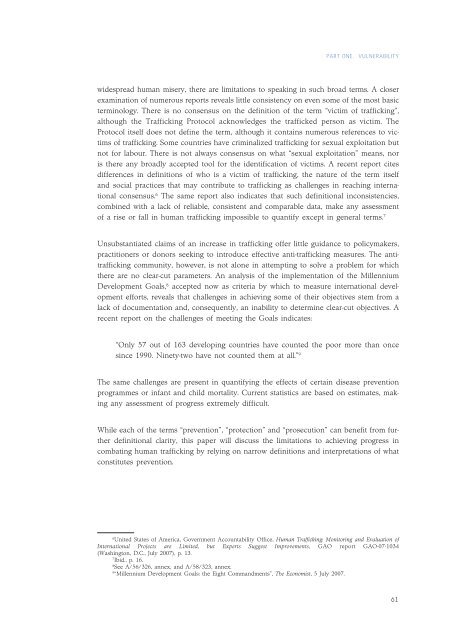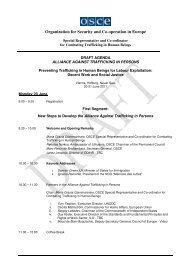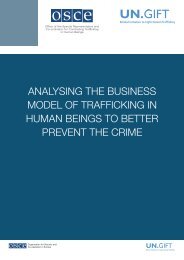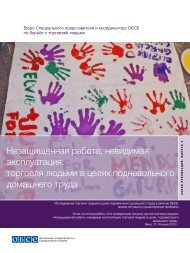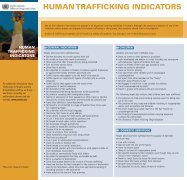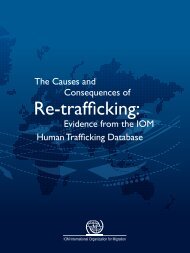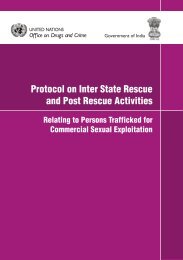An Introduction to Human Trafficking - United Nations Office on ...
An Introduction to Human Trafficking - United Nations Office on ...
An Introduction to Human Trafficking - United Nations Office on ...
Create successful ePaper yourself
Turn your PDF publications into a flip-book with our unique Google optimized e-Paper software.
PART ONE.—VULNERABILITY<br />
widespread human misery, there are limitati<strong>on</strong>s <str<strong>on</strong>g>to</str<strong>on</strong>g> speaking in such broad terms. A closer<br />
examinati<strong>on</strong> of numerous reports reveals little c<strong>on</strong>sistency <strong>on</strong> even some of the most basic<br />
terminology. There is no c<strong>on</strong>sensus <strong>on</strong> the definiti<strong>on</strong> of the term “victim of trafficking”,<br />
although the <str<strong>on</strong>g>Trafficking</str<strong>on</strong>g> Pro<str<strong>on</strong>g>to</str<strong>on</strong>g>col acknowledges the trafficked pers<strong>on</strong> as victim. The<br />
Pro<str<strong>on</strong>g>to</str<strong>on</strong>g>col itself does not define the term, although it c<strong>on</strong>tains numerous references <str<strong>on</strong>g>to</str<strong>on</strong>g> victims<br />
of trafficking. Some countries have criminalized trafficking for sexual exploitati<strong>on</strong> but<br />
not for labour. There is not always c<strong>on</strong>sensus <strong>on</strong> what “sexual exploitati<strong>on</strong>” means, nor<br />
is there any broadly accepted <str<strong>on</strong>g>to</str<strong>on</strong>g>ol for the identificati<strong>on</strong> of victims. A recent report cites<br />
differences in definiti<strong>on</strong>s of who is a victim of trafficking, the nature of the term itself<br />
and social practices that may c<strong>on</strong>tribute <str<strong>on</strong>g>to</str<strong>on</strong>g> trafficking as challenges in reaching internati<strong>on</strong>al<br />
c<strong>on</strong>sensus. 6 The same report also indicates that such definiti<strong>on</strong>al inc<strong>on</strong>sistencies,<br />
combined with a lack of reliable, c<strong>on</strong>sistent and comparable data, make any assessment<br />
of a rise or fall in human trafficking impossible <str<strong>on</strong>g>to</str<strong>on</strong>g> quantify except in general terms. 7<br />
Unsubstantiated claims of an increase in trafficking offer little guidance <str<strong>on</strong>g>to</str<strong>on</strong>g> policymakers,<br />
practiti<strong>on</strong>ers or d<strong>on</strong>ors seeking <str<strong>on</strong>g>to</str<strong>on</strong>g> introduce effective anti-trafficking measures. The antitrafficking<br />
community, however, is not al<strong>on</strong>e in attempting <str<strong>on</strong>g>to</str<strong>on</strong>g> solve a problem for which<br />
there are no clear-cut parameters. <str<strong>on</strong>g>An</str<strong>on</strong>g> analysis of the implementati<strong>on</strong> of the Millennium<br />
Development Goals, 8 accepted now as criteria by which <str<strong>on</strong>g>to</str<strong>on</strong>g> measure internati<strong>on</strong>al development<br />
efforts, reveals that challenges in achieving some of their objectives stem from a<br />
lack of documentati<strong>on</strong> and, c<strong>on</strong>sequently, an inability <str<strong>on</strong>g>to</str<strong>on</strong>g> determine clear-cut objectives. A<br />
recent report <strong>on</strong> the challenges of meeting the Goals indicates:<br />
“Only 57 out of 163 developing countries have counted the poor more than <strong>on</strong>ce<br />
since 1990. Ninety-two have not counted them at all.” 9<br />
The same challenges are present in quantifying the effects of certain disease preventi<strong>on</strong><br />
programmes or infant and child mortality. Current statistics are based <strong>on</strong> estimates, making<br />
any assessment of progress extremely difficult.<br />
While each of the terms “preventi<strong>on</strong>”, “protecti<strong>on</strong>” and “prosecuti<strong>on</strong>” can benefit from further<br />
definiti<strong>on</strong>al clarity, this paper will discuss the limitati<strong>on</strong>s <str<strong>on</strong>g>to</str<strong>on</strong>g> achieving progress in<br />
combating human trafficking by relying <strong>on</strong> narrow definiti<strong>on</strong>s and interpretati<strong>on</strong>s of what<br />
c<strong>on</strong>stitutes preventi<strong>on</strong>.<br />
6<br />
<str<strong>on</strong>g>United</str<strong>on</strong>g> States of America, Government Accountability <str<strong>on</strong>g>Office</str<strong>on</strong>g>, <str<strong>on</strong>g>Human</str<strong>on</strong>g> <str<strong>on</strong>g>Trafficking</str<strong>on</strong>g>: M<strong>on</strong>i<str<strong>on</strong>g>to</str<strong>on</strong>g>ring and Evaluati<strong>on</strong> of<br />
Internati<strong>on</strong>al Projects are Limited, but Experts Suggest Improvements, GAO report GAO-07-1034<br />
(Washing<str<strong>on</strong>g>to</str<strong>on</strong>g>n, D.C., July 2007), p. 13.<br />
7<br />
Ibid., p. 16.<br />
8<br />
See A/56/326, annex, and A/58/323, annex.<br />
9<br />
“Millennium Development Goals: the Eight Commandments”, The Ec<strong>on</strong>omist, 5 July 2007.<br />
61


